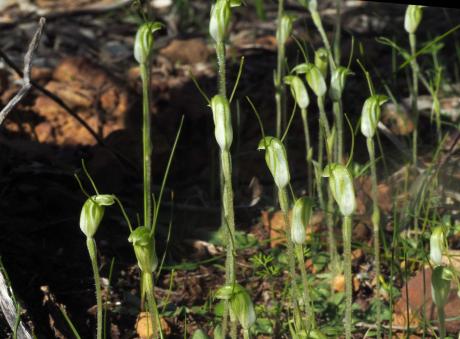Our Walk up Mt Caley 13 June

 When John Oxley passed this way in June 1817 he wrote in his diary “We saw no game with the exception of three or four kangaroo rats, many beautiful small parrots were observed, and as barren as the scrub appeared to us, yet our botanists reaped an excellent harvest here. We passed over a rugged, barren, and rocky country for about four miles and a half when we ascended a hill upon our right which promised a view in all directions. To the southward, south-west and even west the country was a perfect plain, interspersed with more of those dreadful scrubs”. This may not have been Mt Caley or some hill nearby but it does indicate the toughness of the country with the impenetrable Cypress Pine and Acacia that he encountered but also the great diversity of plants found on the hills. He was however looking for grass and water for his horses to keep him going which appeared to be scarce. He called Mt Cayley Cave Hill and we should have looked under the ledge at the cairn for that cave.
When John Oxley passed this way in June 1817 he wrote in his diary “We saw no game with the exception of three or four kangaroo rats, many beautiful small parrots were observed, and as barren as the scrub appeared to us, yet our botanists reaped an excellent harvest here. We passed over a rugged, barren, and rocky country for about four miles and a half when we ascended a hill upon our right which promised a view in all directions. To the southward, south-west and even west the country was a perfect plain, interspersed with more of those dreadful scrubs”. This may not have been Mt Caley or some hill nearby but it does indicate the toughness of the country with the impenetrable Cypress Pine and Acacia that he encountered but also the great diversity of plants found on the hills. He was however looking for grass and water for his horses to keep him going which appeared to be scarce. He called Mt Cayley Cave Hill and we should have looked under the ledge at the cairn for that cave.
On our walk in this relatively wet year we saw mounds of iridescently green mosses and Pomaderris cocoparrana seedlings emerging amongst the rocks with occasional last year’s plants which were larger and had escaped chewing by goats with a few daring to flower.
The common Dwarf Greenhood (Pterostylis nana) was flowering everywhere. The hoods of the individuals in a clump face all different directions, this may be to increase their chances of pollinations by tiny fungi gnats. Remains of Autumn greenhood (Pterostylis revoluta ) were seen and the robust rosettes of Midget Greenhood (Pterostylis mutica) yet to flower in Spring.
Steve turned over a rock to look at termites only to uncover a large green legged centipede (genus Cormocephalus)! It must have been having a feast. Other invertebrates seen were a lovely Australian Golden Orbweaver (Trichonephila edulis) and an iridescent beetle (Pseudotaenia waterhousi). (Thanks to identification from iNaturalist).
The view from the top was how Oxley saw it: to the southward, south-west and even west, the country was perfectly plain, interspersed with more of those dreadful scrubs except we could see Yenda and he didn’t.
In the open flatter parts was a field of Purple Burrdaisy (Calotis cuneifolia) and the yellow of Sticky Everlasting (Xerochrysum viscosa) mixed up with a lot of Raspwort. We wouldn’t want to come here in October for the dread of days removing tiny burrs from all clothing parts.
We adjourned over the road through the Spring Hill picnic area to the short walk to Falcon Falls to check that the necklace fern was still tucked under the rock crevasses of the waterfall and that the Batswing fern was present. The waterfall was just dripping, you need to come here in the rain or very soon after to see it flowing.
No Turquoise Parrots were present today but we saw a few family groups of Speckled Warblers and occasional Eastern Yellow Robins with their flash of yellow and their perchance to perch on the sides of trees. The Brown Treecreepers were also busy checking under bark for beetles and grubs.
A quick visit to Wattle Dam gave Jess an opportunity to do the bird jig when she saw a couple of new birds to her: Splendid Fairywren and Mulga Parrot all in one eyeful.
We achieved something this morning going up that hill, someone said. This is surely proving to be a good year botanically thanks to rain and sunny days.
Nella Smith
Bird List 27 June 2020
Spiny-cheeked Honeyeater White-plumed Honeyeater Willie Wagtail
Striped Honeyeater Grey Fantail Australian Raven
Rufous Whistler Peaceful Dove Bar-shouldered Dove
Grey Shrike-Thrush White-browed Babbler Galah
Mulga Parrot Brown Treecreeper Striated Pardalote
Yellow-rumped Thornbill Speckled Warbler Red-capped Robin
Jacky Winter Grey Butcherbird Splendid Wren

